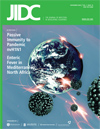Association between HSV-2 and HIV serostatus in pregnant women of known HIV serostatus attending Mulago Hospital antenatal clinic, Kampala, Uganda
DOI:
https://doi.org/10.3855/jidc.230Keywords:
HSV-2, pregnancy, antenatal care, prevalence, HIV infectionAbstract
Background: Studies show that STIs such as HSV-2 increase the probability of HIV-1 acquisition and enhance transmission by increasing susceptibility and infectiousness respectively. The objective of this study was to compare the proportion of HSV-2 in HIV-positive and HIV-negative pregnant mothers attending the antenatal clinic in Mulago Teaching Hospital in Kampala, Uganda.
Methods: This case control study included 50 pregnant women who were HIV positive and 200 controls of pregnant women who were HIV negative and were aware of their serostatus. Data was collected in two parts: the first part involved a pretested interviewer-administered semi-structured questionnaire for socio-demographic characteristics, sexual and behavioral history. The second part consisted of a serological test using an ELISA assay specific for IgG against viral glycoprotein G, specific to HSV-2.
Results: The proportion of HSV-2 was 86% (43/50) among the HIV-positive cases and 62% (125/200) among the HIV-negative controls. The odds of being HSV-2 seropositive was 3.7 times higher (95% CI was 1.58 - 8.61) in HIV-positive cases than in the HIV negative controls. The odds of HSV-2 was significantly increased to 5.32 (95 CI was 1.92 - 14.73) among cases when adjustment was done for age, education, marital status, religion, age at first sexual experience, lifetime partners, type of earning, and whether the mother involved the partner in seeking treatment for sexually transmitted diseases.
Conclusion: The proportion of HSV-2 was higher in HIV-positive cases than in the HIV negative controls.
Downloads
Published
How to Cite
Issue
Section
License
Authors who publish with this journal agree to the following terms:
- Authors retain copyright and grant the journal right of first publication with the work simultaneously licensed under a Creative Commons Attribution License that allows others to share the work with an acknowledgement of the work's authorship and initial publication in this journal.
- Authors are able to enter into separate, additional contractual arrangements for the non-exclusive distribution of the journal's published version of the work (e.g., post it to an institutional repository or publish it in a book), with an acknowledgement of its initial publication in this journal.
- Authors are permitted and encouraged to post their work online (e.g., in institutional repositories or on their website) prior to and during the submission process, as it can lead to productive exchanges, as well as earlier and greater citation of published work (See The Effect of Open Access).








